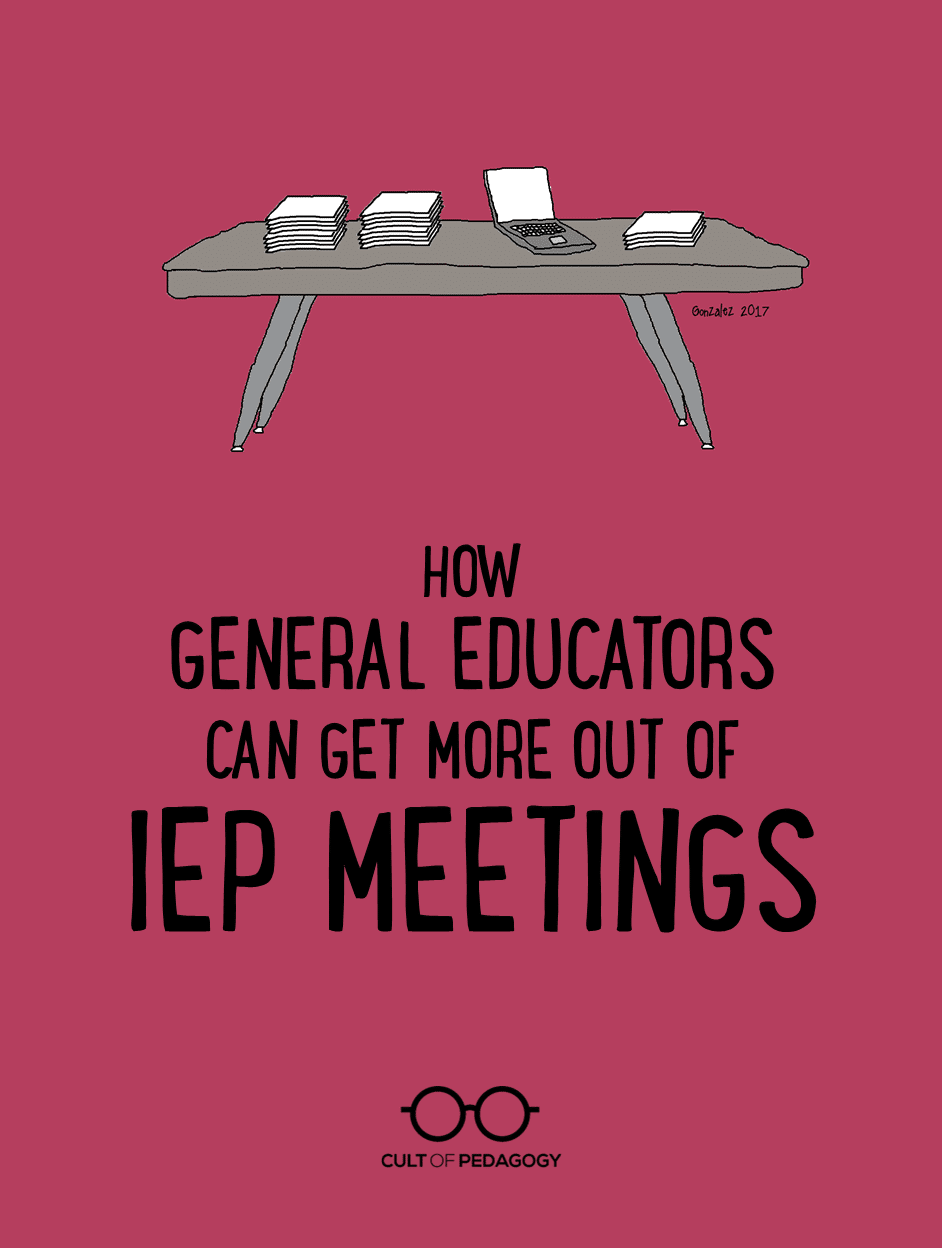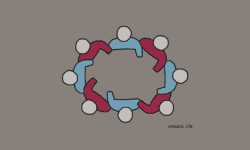
Leena Landmark is an Associate Professor of Special Education at Ohio University.
As a family member, former special educator, and current teacher educator, I’ve participated in a lot of Individualized Education Program (IEP) meetings. Many have been productive and resulted in great plans for children, but other meetings–well, not so much. I’ve seen teachers and administrators rush in and out, grade papers, text, and scarcely acknowledge the student or parents during IEP meetings. I’ve also seen parents look discouraged and passively respond only when spoken to.
If the IEP meeting serves only as a cursory time for the involved parties to sign in agreement, I can understand why some educators and parents aren’t engaged during the time spent at the actual IEP meeting. In particular, I understand the time constraints educators have. Writing lessons, preparing materials, contacting parents, attending meetings, and doing other duties as assigned take teachers away from their favorite part of the job—actually teaching the kids. Yet, by participating more actively in your students’ IEP meetings you have the opportunity to develop relationships with the student and the parents that might not have happened otherwise. A caring educator at an IEP meeting shows the child and parents that you really do have an interest in helping the child be successful. When students and parents feel that an educator cares, they are more supportive of that educator.
Attending IEP meetings can help you learn about what works for the child’s other teachers. Even if you are successfully educating the child, you might pick up some tips to use with other students in your classes.
Participating in IEP meetings also allows you to learn more about the levels of functioning of the child. Most students with IEPs undergo comprehensive evaluations every three years to determine eligibility for special education services, and part of this eligibility is the determination of the child’s educational needs. This information can help you better understand the child’s strengths and needs academically, developmentally, and functionally. Finally, attending IEP meetings can help you learn about what works for the child’s other teachers. Even if you are successfully educating the child, you might pick up some tips to use with other students in your classes.
Importance of the IEP
As the general educator, you have an essential role in the IEP team, but to really understand this importance, you need to understand the value of the IEP.
Prior to the Education of All Handicapped Children Act of 1975 (now known as the Individuals with Disabilities Education Improvement Act [IDEA] of 2004), children with disabilities could be excluded from school. With the passing of this legislation, children with disabilities were guaranteed a free appropriate public education (FAPE). There are two criteria typically used to determine if a child is receiving FAPE: compliance with IEP procedures and receipt of meaningful educational benefit (Yell, Katsiyannis, Ennis, Losinski, & Christle, 2016). General educators impact both of these.
For most students with disabilities, FAPE is provided in the general education classroom. For the few children who are not educated in the general education classroom, there’s still an expectation the child will be involved and progress in the general curriculum. Because the IEP meeting is the time the IEP team members come to agreement about how to provide the child with FAPE, it’s important that the person who knows the most about the general education curriculum (i.e., YOU, the general educator) actively participates in the meeting. Indeed, the input and participation of the general educator in the IEP is an area of compliance that could impact a student’s receipt of FAPE.
Another way general educators impact meaningful educational benefit (and thus, FAPE) is by helping the special educator understand how well the child is performing in the general curriculum. Special educators draft annual goals based on the child’s Present Levels of Academic Achievement and Functional Performance (PLAAFP). PLAAFPs identify the current levels of performance and the impact the disability has on learning in the general curriculum. There should be a direct relationship between the PLAAFPs and annual goals. PLAAFPs are gleaned from a variety of sources including classroom observations, work samples, and input from the child’s teachers (PACER Center, n.d.). A well-written, data-based PLAAFP statement is necessary to write a meaningful, measurable annual goal, and general educators have a vital part in this process.
Before the IEP Meeting
Provide Input
Although special educators are generally charged with drafting the PLAAFPs and annual goals, they need input from the general education teachers to do so. Depending on your school and special education teachers, the data needed from the general education teacher may be gathered in various ways (e.g., pre-IEP meetings between the special and general educators, questionnaires completed by the general educator, or discussions during the IEP meeting). Regardless if the special educator requests this information before the IEP meeting or during the IEP meeting, as the general educator, it is helpful for you to be prepared to provide this feedback and information.
When you receive the notice that an IEP meeting is scheduled, you can begin to compile the information the special educator will need to write the PLFAAP statement and annual goals for your content area. At a minimum, this information should be about how the child is performing in your class (i.e., progressing in the general education curriculum); any recommendations you have regarding annual goals, accommodations, or modifications; and any concerns you have. When preparing this feedback, keep in mind that you need to compare how the child is performing in the general education curriculum for your content area to how the typically developing peer performs so the special educator can write the data-based PLFAAP statements.

During the IEP Meeting
Be Present
If possible, arrive at the IEP meeting on time. By arriving on time you convey your understanding of the importance of the IEP and everyone’s time who is attending. If you do arrive late or leave before the end of the meeting, sincerely apologize to the parent and the child. During the meeting, make a point to really focus on being present. Clear your mind. Don’t read something else or grade papers, and don’t tell the IEP team you are rushed. In other words, do only one thing—participate in the meeting.
Communicate Respectfully
Occasionally, IEP meetings can be tense and uncomfortable. Some parents may become emotional, whereas other parents may appear passive. Hopefully, the parents are active and equal participants in the IEP meeting. No matter their demeanor during the meeting, parents appreciate you telling them the truth about how their child is functioning in your class. Just like any other time you communicate with parents, it’s best to start with something positive about the child before discussing areas for improvement. Because of special education’s roots in the medical model, IEP meetings tend to focus on children’s deficits. Thus, over the years parents have likely experienced many meetings with educators in which their child’s deficits are illuminated. Remember, this child is precious to the parents, and they are sending you the very best child they have. A kind and sincere statement about the child’s strengths will always be appreciated.
When communicating with the parents and the other members of the IEP team, carefully choose your words because the words you use can either hurt or empower others. For example, instead of saying a child has weaknesses in a particular area, say the child has areas for improvement. Again, IEP meetings can be very draining to parents when all they hear is how behind or difficult their child is.
Because of special education’s roots in the medical model, IEP meetings tend to focus on children’s deficits. A kind and sincere statement about the child’s strengths will always be appreciated.
Another tip is to use People First Language (Snow, 2009), even if the parents do not use it. People First Language focuses on the person instead of the characteristic of the disability. Examples of People First Language include student with a learning disability instead of learning disabled student and child with autism instead of autistic child. Although not every person with a disability prefers People First Language, as an educational professional, we should use People First Language unless someone with a disability directly asks us not to. Finally, don’t use the word retard or its derivatives to refer to yourself or someone else who makes a mistake (e.g., I forgot the meeting was today. I’m such a retard!).
Ask Questions
Finally, if you don’t understand a term used by another IEP team member during the meeting, it’s likely the parent doesn’t understand the term either—so ask for clarification. The parent will be relieved that you asked about a confusing term. The other professionals at the meeting will appreciate your willingness to learn.
After the IEP Meeting
Refer to the IEP Document When Planning
If you weren’t given a copy of the relevant annual goals, accommodations, and modifications pertinent to your class shortly after the IEP meeting, ask the special educator for them. When a student with an IEP is in your class, you are the teacher of record for that student. Even if you have a paraprofessional in your classroom to assist the child, it is still your responsibility to develop the instruction for the student (the paraprofessional can implement the instruction under your supervision). This means you are responsible for implementing the IEP as it pertains to your class. When writing your lesson plans, refer to the child’s goals, accommodations, and modifications so you can incorporate them into your lessons. If there is something you don’t understand in the IEP document, ask the special education teacher for assistance.
Track the Child’s Progress
Data were used to write the PLFAAP and annual goals, and data must be used to determine if the student is making progress toward meeting those goals. This means the child’s teachers need to have a way to keep track of the data needed to determine if progress is being made. For some annual goals and corresponding objectives/benchmarks, the student’s grades on assignments may be sufficient data to show progress. For other students, different types of data sources may need to be used. Take the following goal, for example: When interacting with peers, Leslie will maintain at least 2 verbal interactions for 20 seconds each with a peer during recess on 3 of 5 days each week based on direct observation by the teacher. A special educator can help you set up a simple system of tracking the data needed for this goal.
If an accommodation or modification is not working, if the student is not making progress toward their goals, or if an accommodation or modification is no longer needed, contact the special education teacher. It’s very important that the accommodations and modifications listed in the child’s IEP document be implemented in the classroom. If an accommodation or modification needs to be changed, that can easily be done.
Conclusion
Using the tips provided to actively participate before, during, and after the IEP meeting can help you get the most out of your students’ IEPs, thereby helping your students get the most out of their educations. Remember: as the general educator, you are the content expert, and the special educator is the individualization expert. Children who have IEPs need both kinds of teachers. The entire IEP team is available to help you help your students achieve their educational goals. ♦
References
Individuals with Disabilities Education Improvement Act (IDEIA) of 2004, PL 108-446, 20 U.S.C. § 1400 et seq. (2004).
PACER Center. (n.d.). A place to start: Understanding the present level of academic achievement and functional performance statement. Action Information Sheets: PACER. Retrieved from http://www.pacer.org/parent/php/PHP-c186.pdf
Snow, K. (2009). Examples of People First Language. Retrieved from https://www.disabilityisnatural.com/people-first-language.html
Yell, M. L., Katsiyannis, A., Ennis, R. P., Losinski, M, & Christle, C. A. (2016). Avoiding substantive errors in individualized education program development. TEACHING Exceptional Children, 49(1), 31-40.
Join my mailing list and get weekly tips, tools, and inspiration—in quick, bite-sized packages—all geared toward making your teaching more effective and fun. To thank you, I’ll send you a free copy of my e-booklet, 20 Ways to Cut Your Grading Time in Half. I look forward to getting to know you better!





There are so many factors that create tension around the IEP. First, we know that public schools are underfunded and that they don’t have the resources to provide what all kids need. There’s also a huge disconnect between what teachers are taught in college regarding IEPs and what happens in real life. Lastly, it’s a very cumbersome and overwhelming process and it can take months or even years for parents to learn and understand the process. The system is so broken.
This was very valuable information especially as someone who completes 504s!
What a lovely article about the importance of general education teachers and their importance of being a part of the IEP process. However, the reality is our concerns are very rarely taken seriously because we do not have a special education degree. Some of us “regular education teachers” have more practical experience than many of my special education peers. However, the most critical fact, which was already mention in a previous reply is that, especially after the pandemic, there are no resources or staffing available to properly implement the IEP and child study teams make us feel as though we are inadequate as teachers when it is really the entire system.